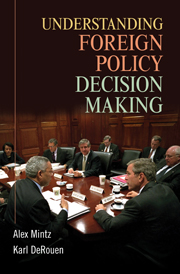Book contents
- Frontmatter
- Contents
- Acknowledgments
- PART ONE INTRODUCTION
- PART TWO THE DECISION ENVIRONMENT
- PART THREE MODELS OF DECISION MAKING
- 4 The Rational Actor Model
- 5 Alternatives to the Rational Actor Model
- PART FOUR DETERMINANTS OF FOREIGN POLICY DECISION MAKING
- PART FIVE MARKETING FOREIGN POLICY
- PART SIX CONCLUSION
- Appendix: Foreign Policy Simulation and Exercise
- References
- Index
5 - Alternatives to the Rational Actor Model
Published online by Cambridge University Press: 05 June 2012
- Frontmatter
- Contents
- Acknowledgments
- PART ONE INTRODUCTION
- PART TWO THE DECISION ENVIRONMENT
- PART THREE MODELS OF DECISION MAKING
- 4 The Rational Actor Model
- 5 Alternatives to the Rational Actor Model
- PART FOUR DETERMINANTS OF FOREIGN POLICY DECISION MAKING
- PART FIVE MARKETING FOREIGN POLICY
- PART SIX CONCLUSION
- Appendix: Foreign Policy Simulation and Exercise
- References
- Index
Summary
In this chapter, we look at alternatives to the rational actor models (see Table 5.1). We focus on bounded rationality and the cybernetic model, bureaucratic politics, organizational politics, and prospect theory. Next we take an in-depth look at a model that combines elements of the rational and cognitive schools – poliheuristic theory. We then analyze the case study of the 1991 U.S. decision not to invade Iraq through six models of decision making. Finally, we discuss the Applied Decision Analysis (ADA) procedure.
BOUNDED RATIONALITY AND THE CYBERNETIC MODEL
The cognitive and rational schools offer different understandings of decision making. Herbert Simon (1985) came up with interesting anthropological-like terms to distinguish rational and cognitive decision makers. He coined the terms Homo economicus to refer to the former, and Homo psychologicus to refer to the latter. Simon distinguished cognitive models on the basis that they assume decision makers have limited information-processing capabilities. Instead of objectively searching all information for the best outcome, decision makers will select an alternative that is acceptable. This is the satisficing behavior described in Chapter 2. Whereas the rational school focuses on the maximizing behavior and the comparison of costs and benefits, the cognitive school probes how humans make decisions and learn in a bounded rational environment. Furthermore, the cognitive school takes into account that humans are selective in the information they use in decision making, use incomplete search processes, and are more likely to select a satisfactory rather than an optimal alternative (Simon 1985, 295).
- Type
- Chapter
- Information
- Understanding Foreign Policy Decision Making , pp. 68 - 94Publisher: Cambridge University PressPrint publication year: 2010

